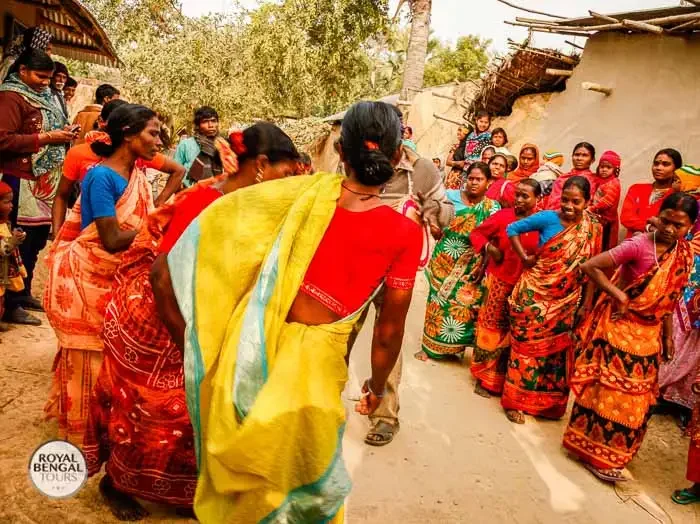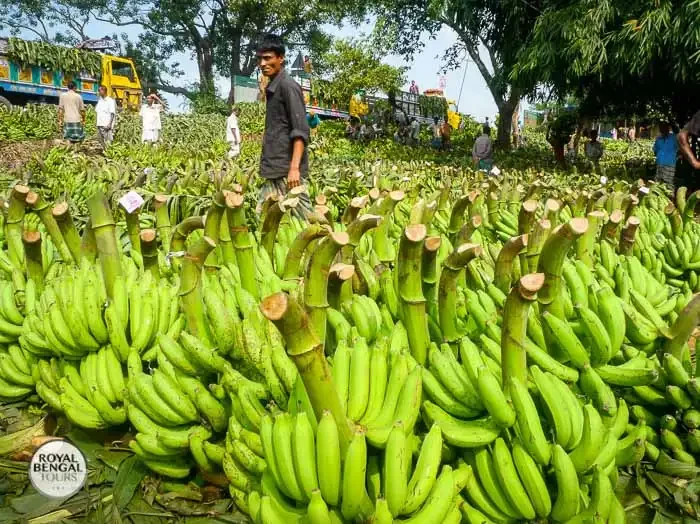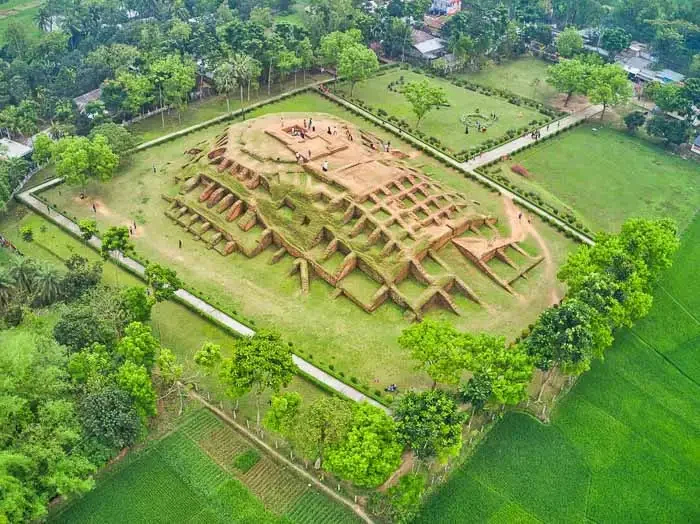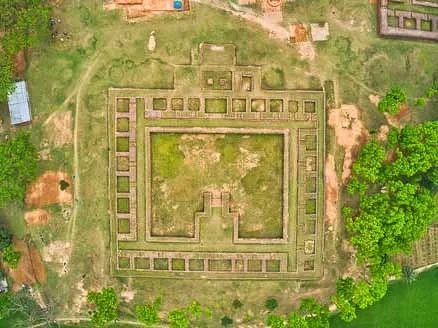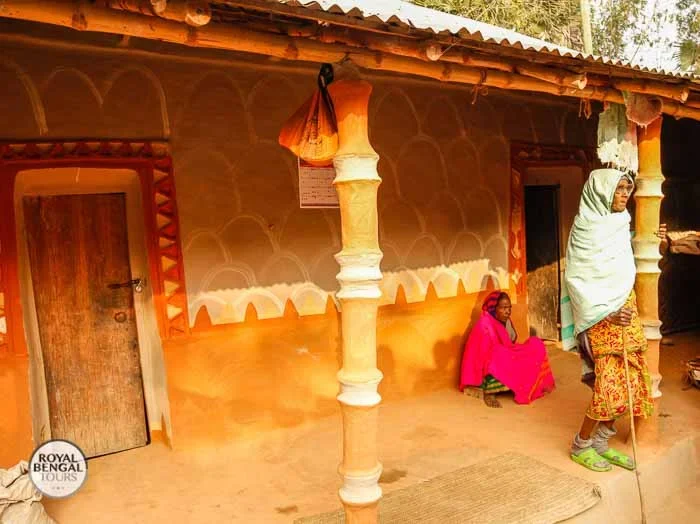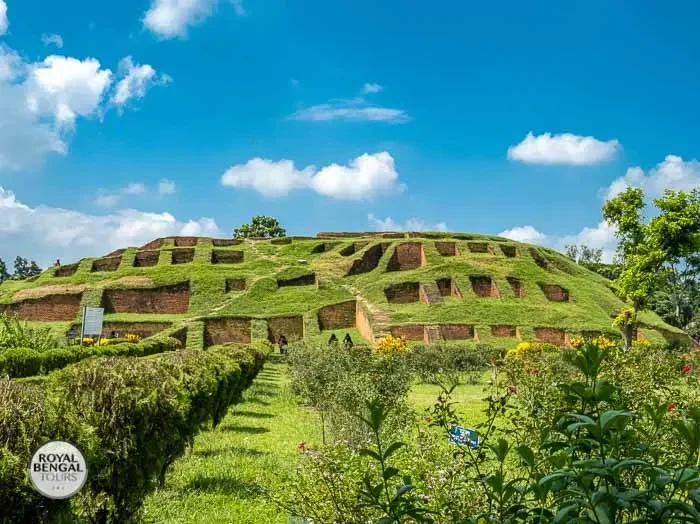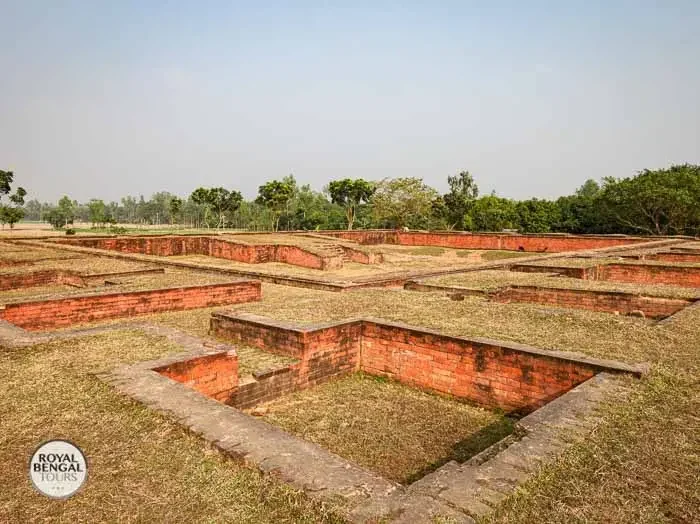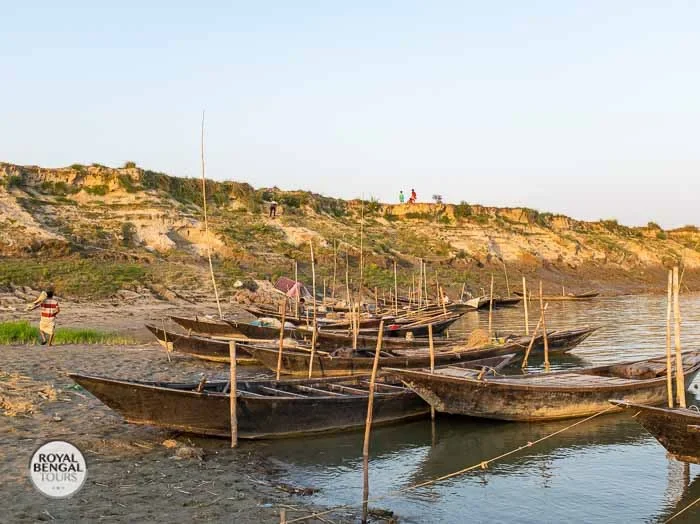rich in Hindu, Buddhist and Muslim sites
First Hindu Capital, from the 3rd century BC.
Bogra - the first Hindu capital from the 3rd century B.C. and holds a variety of important archaeological sites, including a number of Stupas, mausoleums, mosques, Temples, Rajbaris (Land lord’s palaces), British era buildings, flat green landscape, Chars, rivers, and vibrant local culture.
Bogra is believed to have derived its name from Nasiruddin Boghra Khan, son of Delhi Sultan Ghyasuddin Balban. Bogra occupies a significant position in the legends and early historical annals of Bengal and holds an antique city called Pundranagara or Paundravardhanapura in the empire of Pundravardhana, which is now known as Mahasthangarh. It was one of the kingdoms of eastern India during the early historical period and was separated by a river from the more easterly kingdom of Kamarupa or Pragjyotisa. According to the Mahabharata and the Puranas, a powerful prince of the Pundra family, Vasudeva ruled Pundravardhana (Mahasthangarh) back in 1280 BC.
This region was under the authority of the Mauryas during the 4th century, and the Gauda king took it over in the 6th century. Finally, at the beginning of the 7th century, Sasanka emerged as an independent sovereign of Gauda and exercised his authority over Pundravardhana. After his death, this region passed under the rule of the last great Hindu ruler Harshavardhana (606-647 AD). It appears from the tale of the Chinese pilgrim Hiuen Tsang (Xuanzang/Yuan Chwang), who visited this region around 640 AD.
After the death of Sasanka (65C – 750 A. D), political chaos and confusion prevailed in northern Bengal due to the absence of an influential leader. King Yosovarman of Kanauj undertook military expeditions in northern India and defeated the king of Gauda at the beginning of the 8th century. However, it was interrupted by his disastrous defeat at the hand of Lalitaditya, the ruler of Kashmir, who defeats King Yosovarman and ruled the region (c, 724-760 A D). The grandson of King Lalitaditya, Jayapida (779-813 AD), was deserted by his army and followers while on his mission to conquer the world, wandered through Northern India and eventually came to Pundrenagar in disguise and stayed with a temple dance named Kamala. The country at that time was terrorized by a man-eating lion which he killed and ultimately won the hands of the princess of Pundranagar, the daughter of king Jayanta. Jayapida then led, and expeditions against the five Gauda kings defeated them and made his father-in-law Jayanta their overlord. Kalhana and Tibetan historian Lama Taranath’s account of the country, up to the end of 8th century Mahasthan (or Pundranagar), was still the kingdom’s capital to the north of Ganges.
A royal Pala dynasty established control over northern Bengal by the middle of the 8th century, which ended circa 1162 AD with the rise of the Sena dynasty. Vijayasena was the first ruler of the dynasty, originally from the Deccan and settled in West Bengal. He defeated the last Pala king Madan (c. 1143-1162 AD), and his authority took over this region. However, the Sena dynasty nearly came to an end with the collapse of Lakshmana Sena (1178-1204 AD), who was dispelled by Ikhtiyar Uddin Muhammad bin Bakhtiyar Khalji.
Bogra was in peaceful possession of all the Muslim rulers since the Muslim conquest in 1204 AD. Bogra district was under the Mughal authority for about two hundred years and witnessed an era of prosperity and peace until 1757, rarely found in its earlier annals. In 1757 the last independent Nawab of Bengal, Nawab Siraj-Ud-Daulah, was defeated by Robert Clive in the historic battle of Polashi (Plassey). The East India Company captured power in Bengal and Bogra regions and came under the company’s control.
The general features of the region are that of a great plain, unbroken throughout its whole extent. Large rivers like Karatoya, Bangali, Nagor, Jamuna (Brahmaputra), Tulshiganga and a few other streams drift through the greenery of Bogra.


Pundravardhana or Mahasthangarh:
By the third century BCE, complex urban centres were well established in the Bengal floodplains, such as Tamralipti (now Tamluk) in the southwest, Mahasthan in the north Mainamati in the east. The earliest written record of Bangladesh is an inscription on a piece of limestone slab that was discovered in 1931 at Mahasthan excavation. It shows that this city was an important urban centre when the Maurya empire dominated North India. It has been suggested that Mahasthan has been the provincial capital of that empire. The inscription is in Prakrit, a language from which the Bengali language would develop in the tenth century CE, and it appears to be an order to fill up a storehouse with rice, oil, trees and coins against any emergency caused by water, fire or devastation of the crops by parrots. The text is in the Brahmi script, and hence this important discovery is known as the Mahasthan Brahmi Inscription.
So far, eighteen building levels have been discovered in this enormous site enclosed by 6-metre-high rampart walls. This fortified region was in use till the 18th century AD.
This whole area is rich in Hindu, Buddhist and Muslim sites, most of which have vanished. The Buddhist were here until the 11th century AD. Their most remarkable period was between the 8th to 11th century AD, when the Buddhist Pala emperors of North Bengal governed. Most of the visible remains belong to that periods. While there are Muslim and Hindu structures here and there, most are Buddhist.
Even when Bogra has lost the power as an administrative centre, it remained a regular pilgrimage to the Dargah (Mausoleum) of a Muslim warrior – Saint Shah Sultan Mahisawar, the highest mound above a buried Siva temple on the southeastern corner. The Karatoya Mahatayam stated that there were hundreds and thousands of Shiva Lingas in the Pundrakeshetra, based on which O’Donnell mentioned that all those Siva Lingas were set up within a mile range. Thus, the neighbourhood Shibganj might have acquired its name from that source.
Mahasthangarh Site Museum
Maybe relatively small in size and display items. The impressive articles are mainly Buddhist, from the 6th to 13th century AD, is worth visiting. All displays are around in one long room, many old Buddhist terracotta pieces found from the Vasu Bihar excavations, gold ornaments and coins recovered from the Citadel (dating back to the 3rd century BC). The museum is exhibiting richly ornamented female figures with elaborate headdress, semi-divine beings and human, plants of various kinds, animals and composite animals or beings, copper medallions, copper rings, embossed gold amulet and knives, bronze images, some outstanding black basalt stone carvings of various Hindu deities; including Ganesh, Vishnu, Saraswati and Siva (Shiva), to give a glimpse of the mysterious history of this region to its visitors.
The Citadel
The Citadel is adjacent to the museum now. Mahasthangarh comprises the vast ruins of Pundranagar, spreading along the western bank of the Karatoya River. The city headquarter is surrounded by a fortified massive 1524m in length from North to South and 1220m in width wall. It looks like an irregular embankment of about 3m in general elevation above the surrounding level of the country with 14m wide corner bastions that almost qualifies it as a mountain range. The artificial mounds have been built up and raised by intensive habitation on it in about 18 hundred years. Four significant depressions on the rampart at various points probably indicate its original entrances, now bearing popular names:
On the West – Dorab Shah Gate.
On the South – Burir Darwaja
On the West – Tamra Darwaja
On the North – Sanatan Sheber Gali
As of now, only a small part of the entire wall has been discovered. However, if fully unearthed and conserved, this would certainly present a majestic sight.
Jahaj Ghati
A projected semi-circular area of the north arm of the Fortification wall, opposite the Govinda Bhita, is locally known as Jahaj Ghati (Riverport). The excavation of 1960 and 1961 revealed here four major rebuilding phases, the earliest belonging to the Gupta period (4th / 6th century AD), the next assignable to the Palas (9th / 10th century A D), the third one dated to the pre – Islamic period (12th / 13th A D.) and the last phase probably belonged to the Muslim period (15th / 16th century A D.).
The latest phase is represented by a semi-circular derelict bastion, while the pre – Islamic period consists of a series of brick – pitching retained within huge semi-circular boulder alignments. The Pala period is represented here by a massive porch immediately underlying the bastion, indicating a gateway blocked by the boulder alignments of a later period, intended probably to ward off the seasonal inroads of Karatoya. Finally, the earliest phase is represented by two massive parallel walls running towards the Govinda Bhita, each measuring 2.31m wide and 23m long.
Govinda Vita
Govinda Bhita is a majestic structure that remains, revealed in 1928-29 excavation. This isolated high hillock temple located outside the northern rampart wall of the city, on the double band of the River Karatoya. A very picturesque setting and dominant height have made it one of the most important ancient remains in the Mahasthan area. The excavated remains signify four important building from the Gupta period to the late Muslim rule. The temple complex consists of two different temples conveniently named the Eastern Temple and the Western Temple. The Eastern temple is smaller than the earlier Western one. The West one is dated back to the 6th century AD., while the eastern one was built in the 11th century on the same lines but on a smaller scale, and a massive boundary wall enclosed the whole temple complex. Its interesting construction style was a remarkable bricks architecture development in the building art in ancient Bengal.
Govinda Vita Archaeological site entrance fees
|
Nationality |
Ticket Price |
|
Students (Bangladeshi) up to the secondary level |
5.00 taka |
|
Bangladeshi |
10.00 taka |
|
Visitors from SAARC member countries |
50.00 taka |
|
And any other foreign nationalities |
100.00 taka |
Mausoleum (Mazar) of Shah Sultan Balkhi Mahesawar
The Mazar (mausoleum) is standing on the Citadel's southeast corner, near the Mohasthan bus station. Mahasthan's proud position in history as a Capital dwindled steadily, with the fall of the great Pala dynasty in Bengal and consistent shifting of the political focus elsewhere, together with the gradual change in Karatoya River's main channel. It is unknown when exactly Muslim took over this area. Many expert opinions refer that the tomb of a Muslim saint Shah Sultan Balkhi Mahesawar was founded somewhere in the 16th century. The tomb is a plain brick grave, about 13.5m high from the surrounding ground within 3 acres of land.
The most popular legend about the extremely famous saint is that he, originally a Prince of Balkh, came to Mahasthan riding a fish and sought a piece of small land for prayer from ”Parsuram, the ruling Hindu King” where he could expand his prayer skin. The Hindu prince granted his prayer, and the Fakir (Saint) began to pray, turning towards the west. The skin began to expand, and it covered nearly the whole of the city. Alarmed at the king, Parasuram called his troops to attack the Fakir (Saint), but he and his followers died in the battle. Parasurama had a beautiful daughter named Sila Devi, whom the defeater claimed as his prize. The Princes pretended to accept her fate for an opportunity to stab Fakir (Saint) and then sacrifice herself into the River Karatoya. A steep part of the riverbank on the east where there is now a flight of stairs still bears the name of Sila Devi’s Ghat. The local Hindus often identify the name of Mahasthan with ”Sila Dwip” or the “Island of Sila “.
As O’Donnell hints and Beveridge puts it, “the legend of the beautiful Sila Devi has its origin in a mispronunciation. The original name of the place is Siladwip”. O’Donnell also stated that Sila-Dwip was probably derived from the hundred thousand of Siva Lingas set up within a mile area at Mahasthan.
Behula Lakshindarer Basar-ghar
Gokul Medh or Lakshindarer Medh
This gigantic temple is located about 3km south of the Citadel, on the West of Gokul village. The partial Archaeological excavations of 1936 have exposed the origin of an ancient Siva temple, over which a Buddhist stupa was built in the 7th century AD. Local legend has associated this monument with the snake goddess of Manasha.
According to the legend, the mound has acquired its name from the popular tale of Padmapurana. Lakshindar, the youngest son of Chand Saudagar, was bitten by a poisonous snake and died in his bridal chamber, specially built to protect him from the anger of Padma (Manasha). On top of the 13m high lofty mound, an intrusive cell in the centre of a cellular building and One hundred seventy-two rectangular blind cells of various dimensions were found. The stupa had been replaced during the Sena period (11th / 12th century A D) by a square shrine and a porch placed at a slight angle on the plan. The main approach from the western side and the porch had been blocked. The floor level raised to an unknown height. Terracotta plaques and other objects found during the excavation has indicated the late Gupta period (6th / 7th century AD.).
Vasu Bihar or Narapatir Dhap
Vasu Bihar is a remarkable Buddhist archaeological site in this area, located in the midst of beautiful plain surroundings, about 7km Northwest of Mahasthangarh. It is also known as Narapatir Dhap, which consists of five impressive monasteries and a semi-cruciform shrine of considerable height. The oblong-shaped larger two are measuring 148.13m (north-south) by 139m (east-west)'', one (Monument: 1) of them is located on the north, while the other (Monument: 2) one is situated on the north western part of the Dhap.
Monument: -1
Monk cells are on the backside of a veranda around a courtyard. This monastery has 30 cells: 7 each in the eastern and western wings; 8 in the northern wing, excluding a bigger hall in the centre and the inner entrance hall; 8 cells in the south wing. The main entrance approached from the middle of the south wing.
Monument: -2
Twenty-six monk cells (each measuring roughly 10m by 11m) are equally distributed on the four sides of the square courtyard. The main entrance is in the middle of the eastern wing, presented a monumental facade. A pillared entryway hall with an open front porch leads to an inner gallery that is placed in the same order as the cells. There are two guardrooms besides the outer gallery.
The centre of the Dhap is occupied by a medium-sized monument with 6 height, which is the main shrine of this Vasu Vihara Buddhist complex—laying on the southeastern part of the mound, southeast of monastery 2 and to the south of monastery 1. It appears to have been formerly encircled by a moat which is now silted up. At a distance of 320m south of the mound, there is a large water tank known as ”Jhinjrailer Dighi”.
Alexander Cunningham tentatively identified the ruins of the Ashokan stupa and the famous Po-Shi-Po vihara visited by the famous Chinese pilgrim Hiuen Tsang during the 7th century AD. Since 1973 regular excavations on these mounds are in progress. The excavations (1973-74, 1998) yielded a range of minor antiquities, including pottery, terracotta plaques, more than 60 bronze images, decorated bricks and inscribed terracotta sealing, mostly from inside the cells. All the image represents the Buddha or Dhyani Buddha, Bodhishaktis and Bodhisattva. Thus, the site seems to be very rich in archaeological wealth and may prove extremely helpful in reconstructing the obscure early history of the country.
Bihar Dhap or Totaram Panditer Bari
This interesting rectangular mound stands on the western bank of the Nagar river, which passes through the Bihar village; this monument is also popularly known as the home of Totaram Pandit. It is situated about four-kilometre southwest of Mahasthangarh and about 1.5km from Vasu Vihara or Narapatir Dhap. In the late 19th century, Sir Alexander Cunningham identified this mound with the Po-Shi-Po Buddhist monastery visited by Hiuen Tsang between 638 AD and 645 AD.
The hillock-shaped archaeological site of Bihar Dhap was measured as 220m from north to south and 250m long from east to west with an average 2m height. Two Buddhist monasteries were constructed side by side, discovered in the western part after several excavations between 1979 to 1986. Another temple was also partially revealed on the eastern side. During the latest excavation in 2005, the remains of another temple have discovered beside the temple unearthed earlier. The main entrance of both the temples was on the northern side.
Many different types of archaeological elements were discovered from Bihar Dhap. A silver coin from Sultan Sikandar Shah’s period (1358-1390) is the most remarkable one, seal made of burnt clay, 60 terracotta plaques illustrated with paintings, 100 ornamented bricks, globes made of brunt clay and lamps, toys, small pearl-shaped balls of glass and burnt clay, objects made of bronze, iron nails and chalks.
Through a series of analytical studies of characteristics of relevant archaeological objects and reviews of the architecture built in the first phase, the period has been identified between the fourth to the fifth century AD. The 2nd and 3rd phases of construction have been dated back from the sixth to the tenth century AD. Old tricks were used in most architectures of the fourth and fifth phase buildings.
Mahasthangarh Archaeological site, Museum, Citadel, Govinda Vita, Gokul Medh and Vasu Bihar visiting hours
|
Days |
Summer: April to September | Winter: October to March |
During Ramadan |
|
Friday |
10:00 AM to 12:00 PM and 2:00 PM to 6:00 PM | 9:00 AM to 12 PM, and 2 PM to 5 PM |
2.00 PM- 4.00 PM |
|
Saturday |
10:00 AM to 6:00 PM | 9:00 AM to 5:00 PM |
10:00 AM to 4:00 PM |
|
Sunday |
The museum remains closed on Sunday and any other public holidays. |
||
|
Monday |
2:00 PM to 6:00 PM | 1:30 PM to 5:00 PM |
10:00 AM to 4:00 PM |
|
Tuesday |
10:00 AM to 6:00 PM | 9:00 AM to 5:00 PM |
10:00 AM to 4:00 PM |
|
Wednesday |
10:00 AM to 6:00 PM | 9:00 AM to 5:00 PM |
10:00 AM to 4:00 PM |
|
Thursday |
10:00 AM to 6:00 PM | 9:00 AM to 5:00 PM |
10:00 AM to 4:00 PM |
Ramadan visiting hours may vary depending on which season Ramadan falls in.
Mahasthangarh Archaeological sites and Museum entrance fees
Bogra Mahasthangarh Archaeological site, Mahasthangarh Museum, Citadel and Gokul Medh requires separate tickets from each of the sites and museum for each visitor's visit. Vasu Bihar archaeological site still does not require any ticket to visit it.
Every visitor must collect a ticket to enter Bogra’s individual archaeological sites and museums. One ticket will not cover more than one site, visitor should collect entry tickets from each of the sites and museums (Mahasthangarh Archaeological site, Mahasthangarh Site Museum, Citadel/ Jahaj Ghati, Govinda Vita, Gokul Medh) separately. Every Monday from morning to 1:30 PM / 2 PM, the museum will remain closed, but all the sites/ temples must be open for visitors. The ticket price varies depending on the visitor’s nationality.
|
Nationality |
Ticket Price |
|
Students (Bangladeshi) up to the secondary level |
5.00 taka |
|
Bangladeshi |
20.00 Taka |
|
Visitors from SAARC member countries |
100.00 Taka |
|
And any other foreign nationalities |
200.00 Taka |
No entry fee is required for disabled persons and children under three years.
The South Asian Association for Regional Cooperation (SAARC) has eight member countries (Afghanistan, Bangladesh, Bhutan, India, the Maldives, Nepal, Pakistan, and Sri Lanka).
Dos and don’ts inside the Ahsan Manzil Museum
- Do not touch any display items inside or outside the museum!
- Eating, smoking, spitting, photographing, and speaking on mobile phones are strictly prohibited.
- The visitor must keep their entry ticket until their visit is finished.
- A ticket will be valid for the date it was issued and can’t be transferred to another person or any other day.
- The entry ticket sales counter will be closed at least 30 minutes before the museum closing time.
